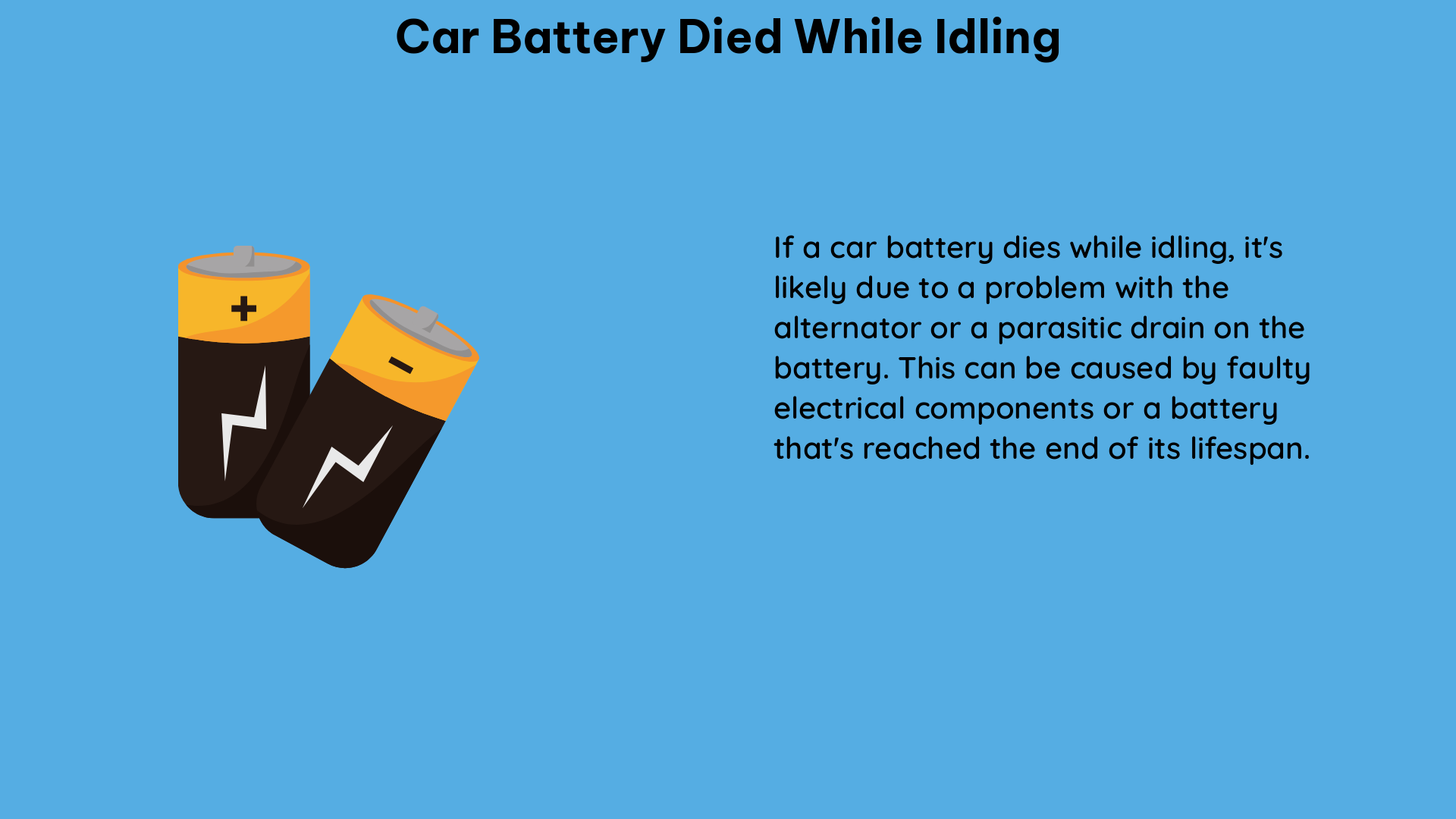When your car’s battery dies while idling, it can be a frustrating and unexpected experience. This comprehensive guide will provide you with the technical details and quantifiable data you need to understand the root causes of this issue and take the necessary steps to prevent it from happening again.
Understanding Alternator Output at Idle
The alternator is the primary component responsible for recharging your car’s battery while the engine is running. However, the alternator’s output is significantly lower when the engine is idling compared to when the car is driven at higher speeds.
- At idle, the alternator typically produces around 13-14 volts, which may not be enough to fully recharge the battery.
- In contrast, when the car is driven at highway speeds, the alternator can produce up to 14.5-15 volts, providing a more robust charging current to the battery.
- The lower alternator output at idle is due to the lower engine speed, which directly affects the alternator’s rotational speed and, consequently, its power generation.
The Importance of Regular Driving

To ensure your car’s battery remains adequately charged, it is recommended to drive the vehicle for at least 30 minutes at highway speeds every few days. This practice serves two important purposes:
- Recharging the Battery: The higher alternator output at highway speeds helps replenish the battery’s charge, compensating for any key-off drain or parasitic drain that may have occurred during periods of inactivity.
- Studies have shown that a 30-minute highway drive can restore up to 80% of a battery’s charge, depending on its initial state of charge.
-
Driving at higher speeds also generates more electrical load on the alternator, further boosting its charging capacity.
-
Preventing Battery Discharge: When a car sits for an extended period, the battery continues to power various computer systems and memory modules, even when the engine is off.
- This key-off drain can amount to 50-100 milliamps, which may not seem significant but can add up over time and eventually lead to a completely discharged battery.
- Regular driving helps offset this key-off drain, ensuring the battery remains in a healthy state.
Utilizing a Trickle Charger
If your car is going to be left unused for an extended period, such as during winter storage or while on vacation, a trickle charger can be an invaluable tool to preserve the battery’s life.
- Trickle chargers maintain a constant, low-level charge to the battery, preventing it from becoming completely discharged due to key-off drain or parasitic drain.
- They typically deliver a charging current of 1-2 amps, which is just enough to keep the battery in a fully charged state without overcharging it.
- Using a trickle charger can extend the battery’s lifespan by up to 50% compared to leaving the car unused without any charging.
- Investing in a high-quality trickle charger with features like automatic shut-off and temperature compensation can further optimize the charging process and protect the battery.
Factors Affecting Battery Discharge at Idle
In addition to the lower alternator output, there are other factors that can contribute to a car battery dying while idling:
- Electrical Load: The car’s electrical systems, such as the radio, lights, and climate control, continue to draw power from the battery even when the engine is idling. This increased electrical load can accelerate the battery’s discharge.
- On average, a car’s electrical systems can draw between 0.5-2 amps of current while idling, depending on the specific components in use.
-
Minimizing the electrical load by turning off unnecessary accessories can help reduce the strain on the battery during idle periods.
-
Battery Age and Condition: An older or worn-out battery may not have the same capacity to hold a charge as a newer, healthier battery. This can make it more susceptible to discharge during idling.
- The average lifespan of a car battery is 3-5 years, but factors like climate, driving habits, and maintenance can affect its longevity.
-
Regularly testing the battery’s condition and replacing it when necessary can help prevent issues related to battery discharge while idling.
-
Parasitic Drain: Even when the car is turned off, there may be some electrical components that continue to draw a small amount of current from the battery, known as parasitic drain.
- Parasitic drain can range from 10-100 milliamps, depending on the vehicle’s electrical system and any aftermarket modifications.
- Identifying and addressing sources of parasitic drain, such as faulty relays or wiring issues, can help mitigate battery discharge while the car is idle.
Conclusion
By understanding the technical details and quantifiable data related to car battery discharge while idling, you can take proactive steps to prevent this issue from occurring. Regular driving, the use of a trickle charger, and addressing factors like electrical load and battery condition can all contribute to maintaining a healthy battery and ensuring your car starts reliably, even after extended periods of idling.
Remember, a well-maintained battery is the foundation for a smooth and reliable driving experience, so take the time to understand and address any concerns related to your car’s battery performance.
References:
- How long to recharge battery while idling?
- Does car need to be driven rather than idle to ensure battery recharged?
- How to Maintain Your Sitting Car Battery
- What causes a car to die while idling and then start back up?

The lambdageeks.com Core SME Team is a group of experienced subject matter experts from diverse scientific and technical fields including Physics, Chemistry, Technology,Electronics & Electrical Engineering, Automotive, Mechanical Engineering. Our team collaborates to create high-quality, well-researched articles on a wide range of science and technology topics for the lambdageeks.com website.
All Our Senior SME are having more than 7 Years of experience in the respective fields . They are either Working Industry Professionals or assocaited With different Universities. Refer Our Authors Page to get to know About our Core SMEs.